Page 126 of 406
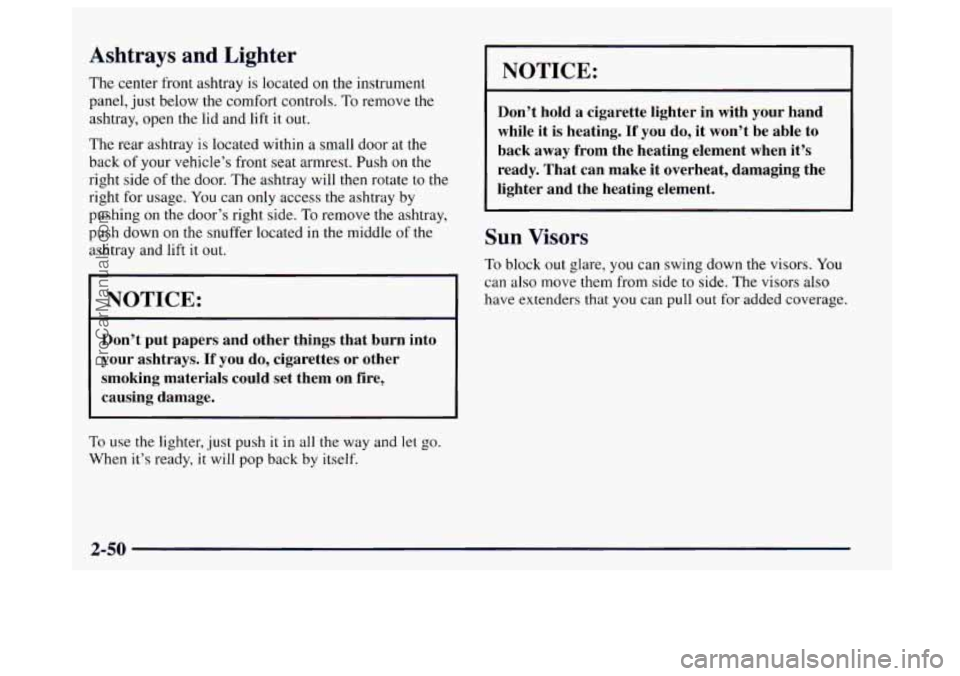
Ashtrays and Lighter
The center front ashtray is located on the instrument
panel, just below the comfort controls. To remove the
ashtray, open the lid and lift it out.
The rear ashtray is located within
a small door at the
back of your vehicle’s front
seat armrest. Push on the
right side of the door. The ashtray will then rotate to the
right for usage.
You can only access the ashtray by
pushing
on the door’s right side. To remove the ashtray,
push down on the snuffer located
in the middle of the
ashtray and lift
it out.
NOTICE:
Don’t put papers and other things that burn into
your ashtrays.
If you do, cigarettes or other
smoking materials could set them on fire,
causing damage.
To use the lighter, just push it in all the way and let go.
When it’s ready, it will pop back by itself. Don’t hold a cigarette lighter in with your
hand
while it is heating.
If you do, it won’t be able to
back away from the heating element when it’s
ready. That can make it overheat, damaging the
lighter and the heating element.
Sun Visors
To block out glare, you can swing down the visors. You
can
also move them from side to side. The visors also
have extenders that
you can pull out for added coverage.
2-50
ProCarManuals.com
Page 129 of 406
Instrument Panel -- Your Information System
A. Lamp Controls
B. Instrument Cluster
C. Vents
D. Glove Box
E. Audio System
E Climate Control
2-53
ProCarManuals.com
Page 130 of 406
Instrument Panel Cluster
Standard Cluster: United States Version Shown, Canadian Similar
Your instrument cluster is designed to let you know at a glance how your vehicle is running. You’ll know how fast
you’re going, about
how much fuel is in your tank and many other things you need to drive safely and economically.
2-54
ProCarManuals.com
Page 132 of 406
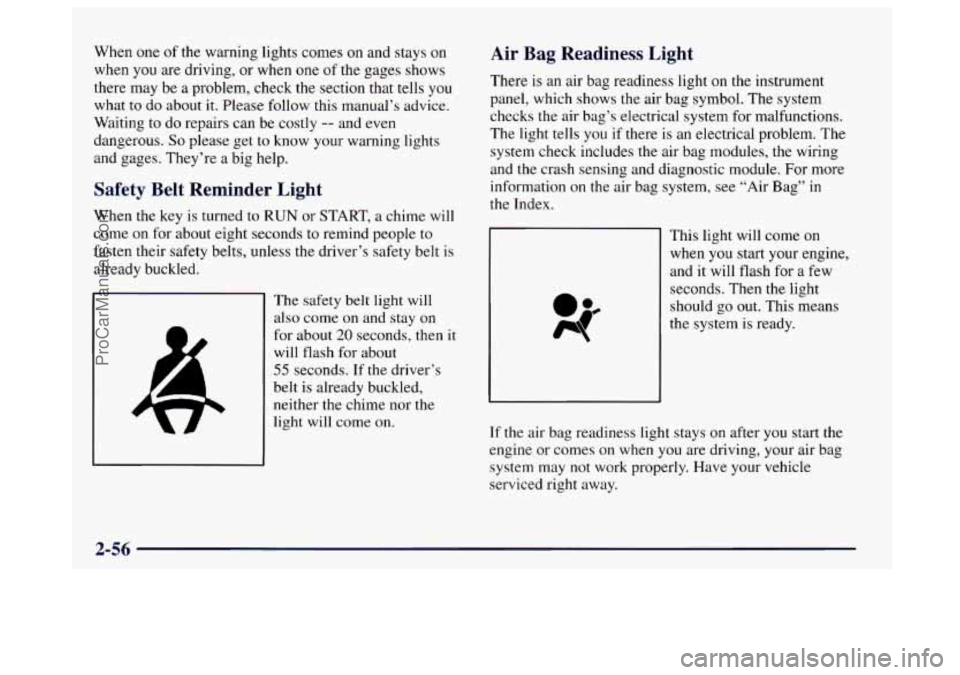
When one of the warning lights comes on and stays on
when
you are driving, or when one of the gages shows
there may be a problem, check the section that tells you
what to do about
it. Please follow this manual’s advice.
Waiting
to do repairs can be costly -- and even
dangerous.
So please get to know your warning lights
and gages. They’re a big help.
Safety Belt Reminder Light
When the key is turned to RUN or START, a chime will
come on for about eight seconds to remind people to
fasten their safety belts, unless the driver’s safety belt
is
already buckled.
The safety belt light will
also come on and stay on
for about
20 seconds, then it
will flash for about
55 seconds. If the driver’s
belt is already buckled,
neither the chime nor the
light
will come on.
Air Bag Readiness Light
There is an air bag readiness light on the instrument
panel, which shows the air bag symbol. The system
checks the air bag’s electrical system for malfunctions.
The light tells you if there is an electrical problem. The
system check includes the air bag modules, the wiring
and the crash sensing and diagnostic module. For more
information
on the air bag system, see “Air Bag” in
the Index.
This right will come on
when you start your engine,
and it will flash for a few
seconds. Then the light
should
go out. This means
the system is ready.
If the air bag readiness light stays
on after you start the
engine or comes on when
you are driving, your air bag
system may not work properly. Have your vehicle
serviced right away.
2-56
ProCarManuals.com
Page 144 of 406
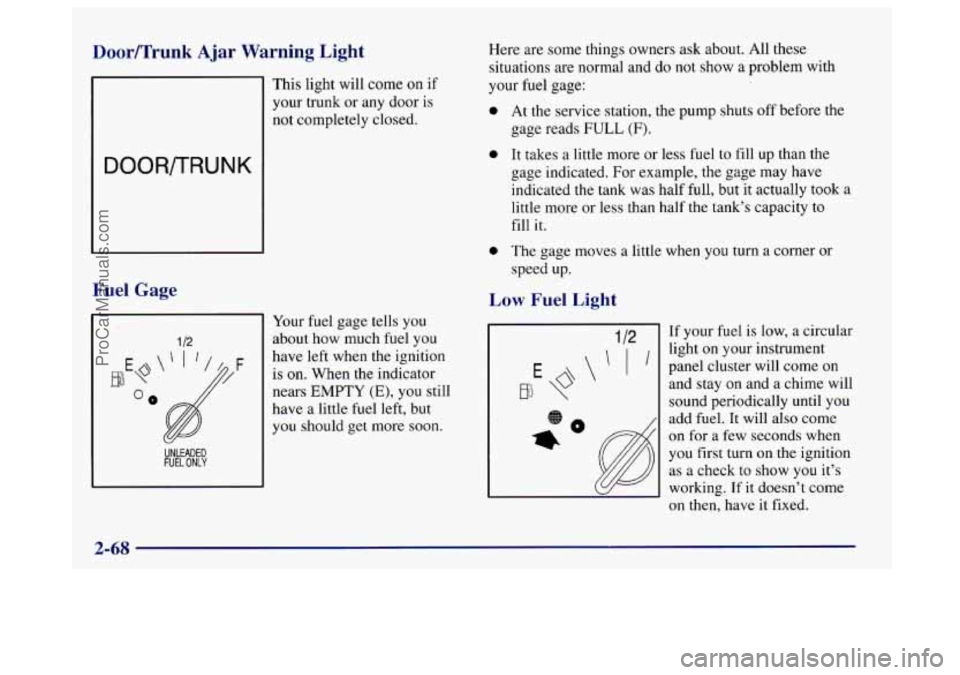
Door/Trunk Ajar Warning Light
DOORDRUNK
Fuel Gage
This light will come on if
your trunk
or any door is
not completely closed.
Your fuel gage tells you
about how much fuel you
have left when the ignition
is on. When the indicator
nears
EMPTY (E), you still
have a little fuel left, but
you should get more soon. Here
are some things owners
ask about. All these
situations are normal and
do not show a problem with
your
fuel gage:
0
0
0
At the service station, the pump shuts off before the
gage reads
FULL (F).
It takes a little more or less fuel to fill up than the
gage indicated. For example, the gage may have
indicated
the tank was half full, but it actually took a
little more or less than half the tank’s capacity to
fill it.
The gage moves
a little when you turn a corner or
speed
up.
Low Fuel Light
If your fuel is low, a circular
light on your instrument
panel cluster will come on
and stay on and a chime will
sound periodically until you
add fuel.
It will also come
on for a few seconds when
you first turn on the ignition
as a check to show you it’s
working.
If it doesn’t come
on then, have
it fixed.
2-68
ProCarManuals.com
Page 146 of 406

Comfort Controls
Manual Single Zone Climate Control
- .
0 IIl
COMFORT CONTROL II
With this system, you can control the heating, cooling
and ventilation in your vehicle. The system works best
if
you keep your windows closed while using it.
Fan Knob
The left knob selects the amount of air you want. To turn
the fan
off, turn the knob to OFF.
If the airflow seems very low when
the fm knob is
turned
to the highest setting, regardless of the mode
setting, your passenger compartment air filter may
need
to be replaced. See "Maintenance Schedule" in
the Index.
Temperature Knob
The center knob changes the temperature of the air
coming through the system. Turn this knob toward
red (clockwise) for warmer air. Turn it toward blue
(counterclockwise) for cooler air.
Mode Knob
The right knob has several settings to control the
direction of airflow:
MAX: This setting recirculates much of the air inside
your vehicle and sends it through the instrument panel
outlets. The air conditioning compressor will run
automatically in this setting unless the outside
temperature is below 40°F
(4°C). (Even when the
compressor is running, you can control the temperature.)
NORM: This setting brings in outside air and sends
it through the instrument panel outlets. The air
conditioning compressor will run automatically in
this setting unless the outside temperature is below
40°F (4°C). (Even when the compressor is running,
you can control the temperature.)
3-2
ProCarManuals.com
Page 147 of 406
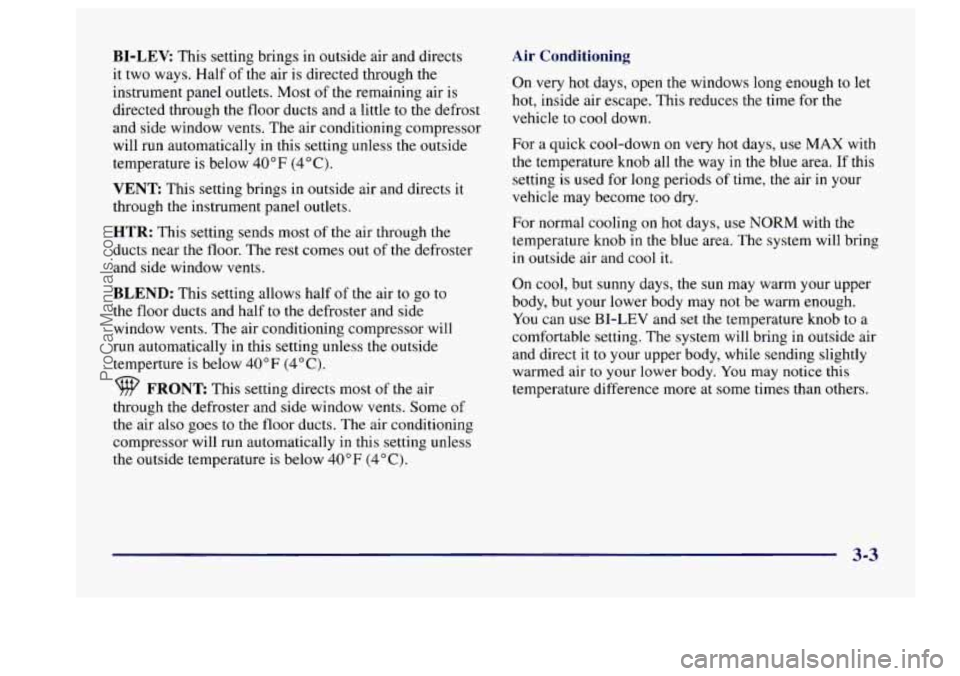
BI-LEV: This setting brings in outside air and directs
it two ways. Half
of the air is directed through the
instrument panel outlets. Most of the remaining air is
directed through the floor ducts and a little
to the defrost
and side window vents. The air conditioning compressor
will run automatically in this setting unless the outside
temperature is below 40°F (4°C).
VENT This setting brings in outside air and directs it
through the instrument panel outlets.
HTR: This setting sends most of the air through the
ducts near
the floor. The rest comes out of the defroster
and side window vents.
BLEND: This setting allows half of the air to go to
the floor ducts and half to the defroster and side
window vents. The air conditioning compressor will
run automatically in this setting unless the outside
temperture is below 40°F (4°C).
9 FRONT This setting directs most of the air
through the defroster and side window vents. Some
of
the air also goes to the floor ducts. The air conditioning
compressor will run automatically in this setting unless
the outside temperature is below
40°F (4°C).
Air Conditioning
On very hot days, open the windows long enough to let
hot, inside air escape. This reduces the time for the
vehicle to cool down.
For a quick cool-down
on very hot days, use MAX with
the temperature knob all the way
in the blue area. If this
setting is used for long periods of time,
the air in your
vehicle may become too dry.
For normal cooling on hot days,
use NORM with the
temperature knob in the blue area. The system will bring
in outside air and cool it.
On cool, but sunny days, the sun may warm your upper
body, but your lower body may not be warm enough.
You can use BI-LEV and set the temperature knob to a
comfortable setting. The system will bring in outside air
and direct
it to your upper body, while sending slightly
warmed air
to your lower body. You may notice this
temperature difference more at some times than others.
3-3
ProCarManuals.com
Page 149 of 406
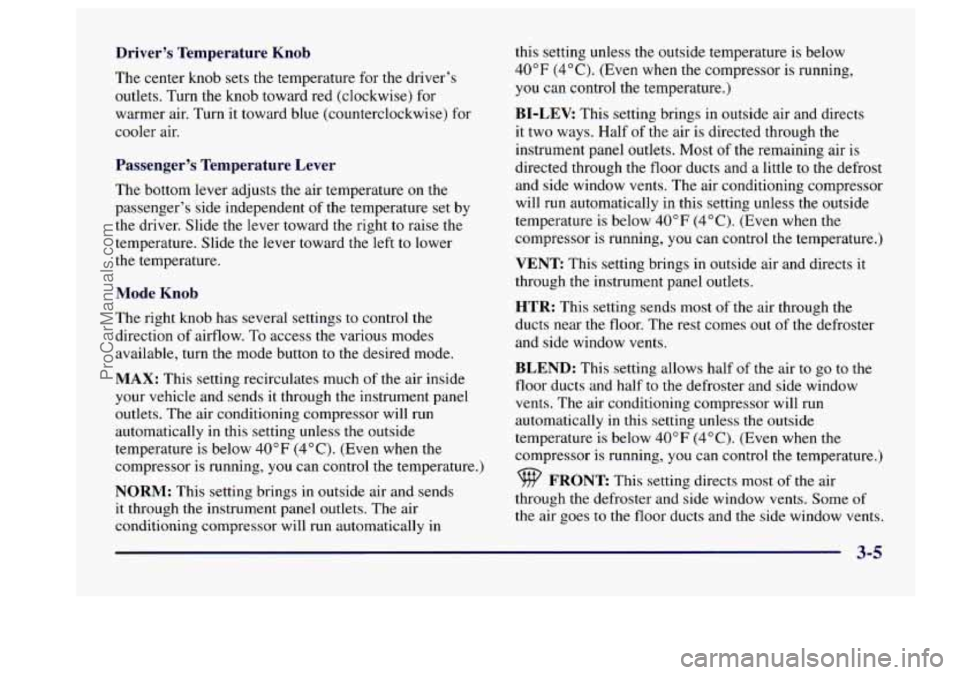
Driver’s Temperature Knob
The center knob sets the temperature for the driver’s
outlets. Turn the knob toward red (clockwise) for
warmer air. Turn it toward blue (counterclockwise) for
cooler air.
Passenger’s Temperature Lever
The bottom lever adjusts the air temperature on the
passenger’s side independent of the temperature set by
the driver. Slide
the lever toward the right to raise the
temperature. Slide the lever toward
the left to lower
the temperature.
Mode Knob
The right knob has several settings to control the
direction of airflow. To access the various modes
available, turn the mode button to the desired mode.
MAX: This setting recirculates much of the air inside
your vehicle and sends it through the instrument panel
outlets. The air conditioning compressor will run
automatically in this setting unless the outside
temperature is below 40°F (4°C). (Even when
the
compressor is running, you can control the temperature.)
NORM: This setting brings in outside air and sends
it through the instrument panel outlets. The air
conditioning compressor will run automatically
in
this setting unless the outside temperature is below
40°F
(4°C). (Even when the compressor is running,
you can control the temperature.)
BI-LEV This setting brings in outside air and directs
it two ways. Half
of the air is directed through the
instrument panel outlets. Most of the remaining air
is
directed through the floor ducts and a little to the defrost
and side window vents. The air conditioning compressor
will
run automatically in this setting unless the outside
temperature is below 40°F (4°C). (Even when the
compressor
is running, you can control the temperature.)
VENT This setting brings in outside air and directs it
through the instrument panel outlets.
HTR: This setting sends most of the air through the
ducts near
the floor. The rest comes out of the defroster
and side window vents.
BLEND: This setting allows half of the air to go to the
floor ducts and half to the defroster and side window
vents. The air conditioning compressor will run
automatically in this setting unless the outside
temperature is below 40°F (4°C). (Even when the
compressor is running, you can control
the temperature.)
FRONT This setting directs most of the air
through the defroster and side window vents. Some
of
the air goes to the floor ducts and the side window vents.
3-5
ProCarManuals.com